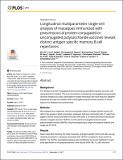| dc.contributor.author | McNeil, Lisa K. | |
| dc.contributor.author | Scully, Ingrid L. | |
| dc.contributor.author | Pride, Michael W. | |
| dc.contributor.author | Liberator, Paul A. | |
| dc.contributor.author | Jansen, Kathrin U. | |
| dc.contributor.author | Jia, Bin | |
| dc.contributor.author | Dupont, Christopher D | |
| dc.contributor.author | Tsioris, Konstantinos | |
| dc.contributor.author | Barry, Rachel M | |
| dc.contributor.author | Ogunniyi, Adebola Oluwakayode | |
| dc.contributor.author | Gonzalez, Christopher L. | |
| dc.contributor.author | Gierahn, Todd Michael | |
| dc.contributor.author | Love, John C | |
| dc.date.accessioned | 2018-01-22T16:34:17Z | |
| dc.date.available | 2018-01-22T16:34:17Z | |
| dc.date.issued | 2017-09 | |
| dc.date.submitted | 2015-10 | |
| dc.identifier.issn | 1932-6203 | |
| dc.identifier.uri | http://hdl.handle.net/1721.1/113258 | |
| dc.description.abstract | This is an open access article distributed under the terms of the Creative Commons Attribution License, which permits unrestricted use, distribution, and reproduction in any medium, provided the original author and source are credited. Background The efficacy of protein-conjugated pneumococcal polysaccharide vaccines has been well characterized for children. The level of protection conferred by unconjugated polysaccharide vaccines remains less clear, particularly for elderly individuals who have had prior antigenic experience through immunization with unconjugated polysaccharide vaccines or natural exposure to Streptococcus pneumoniae. Methods We compared the magnitude, diversity and genetic biases of antigen-specific memory B cells in two groups of adult cynomolgus macaques that were immunized with a 7-valent conjugated vaccine and boosted after five years with either a 13-valent pneumococcal polysaccharide conjugate vaccine (13vPnC) or a 23-valent unconjugated pneumococcal polysaccharide vaccine (23vPS) using microengraving (a single-cell analysis method) and single-cell RT-PCR. Results Seven days after boosting, the mean frequency of antigen-specific memory B cells was significantly increased in macaques vaccinated with 13vPnC compared to those receiving 23vPS. The 13vPnC-vaccinated macaques also exhibited a more even distribution of antibody specificities to four polysaccharides in the vaccine (PS4, 6B, 14, 23F) that were examined. However, single-cell analysis of the antibody variable region sequences from antigen-specific B cells elicited by unconjugated and conjugated vaccines indicated that both the germline gene segments forming the heavy chains and the average lengths of the Complementary Determining Region 3 (CDR3) were similar. Conclusions Our results confirm that distinctive differences can manifest between antigen-specific memory B cell repertoires in nonhuman primates immunized with conjugated and unconjugated pneumococcal polysaccharide vaccines. The study also supports the notion that the conjugated vaccines have a favorable profile in terms of both the frequency and breadth of the anamnestic response among antigen-specific memory B cells. | en_US |
| dc.description.sponsorship | National Institute of Allergy and Infectious Diseases (U.S.) (Grant F32AI112359) | en_US |
| dc.description.sponsorship | National Cancer Institute (U.S.) (Grant P30CA140514) | en_US |
| dc.publisher | Public Library of Science | en_US |
| dc.relation.isversionof | http://dx.doi.org/10.1371/journal.pone.0183738 | en_US |
| dc.rights | Creative Commons Attribution 4.0 International License | en_US |
| dc.rights.uri | http://creativecommons.org/licenses/by/4.0 | en_US |
| dc.source | PLoS | en_US |
| dc.title | Longitudinal multiparameter single-cell analysis of macaques immunized with pneumococcal protein-conjugated or unconjugated polysaccharide vaccines reveals distinct antigen specific memory B cell repertoires | en_US |
| dc.type | Article | en_US |
| dc.identifier.citation | Jia, Bin et al. “Longitudinal Multiparameter Single-Cell Analysis of Macaques Immunized with Pneumococcal Protein-Conjugated or Unconjugated Polysaccharide Vaccines Reveals Distinct Antigen Specific Memory B Cell Repertoires.” Edited by Ray Borrow. PLOS ONE 12, 9 (September 2017): e0183738 © 2017 Jia et al | en_US |
| dc.contributor.department | Massachusetts Institute of Technology. Department of Chemical Engineering | en_US |
| dc.contributor.department | Koch Institute for Integrative Cancer Research at MIT | en_US |
| dc.contributor.mitauthor | Jia, Bin | |
| dc.contributor.mitauthor | Dupont, Christopher D | |
| dc.contributor.mitauthor | Tsioris, Konstantinos | |
| dc.contributor.mitauthor | Barry, Rachel M | |
| dc.contributor.mitauthor | Ogunniyi, Adebola Oluwakayode | |
| dc.contributor.mitauthor | Gonzalez, Christopher L. | |
| dc.contributor.mitauthor | Gierahn, Todd Michael | |
| dc.contributor.mitauthor | Love, John C | |
| dc.relation.journal | PLOS ONE | en_US |
| dc.eprint.version | Final published version | en_US |
| dc.type.uri | http://purl.org/eprint/type/JournalArticle | en_US |
| eprint.status | http://purl.org/eprint/status/PeerReviewed | en_US |
| dc.date.updated | 2018-01-19T17:00:06Z | |
| dspace.orderedauthors | Jia, Bin; McNeil, Lisa K.; Dupont, Christopher D.; Tsioris, Konstantinos; Barry, Rachel M.; Scully, Ingrid L.; Ogunniyi, Adebola O.; Gonzalez, Christopher; Pride, Michael W.; Gierahn, Todd M.; Liberator, Paul A.; Jansen, Kathrin U.; Love, J. Christopher | en_US |
| dspace.embargo.terms | N | en_US |
| dc.identifier.orcid | https://orcid.org/0000-0002-4501-4516 | |
| dc.identifier.orcid | https://orcid.org/0000-0003-1387-8472 | |
| dc.identifier.orcid | https://orcid.org/0000-0003-0921-3144 | |
| mit.license | PUBLISHER_CC | en_US |
